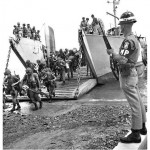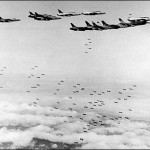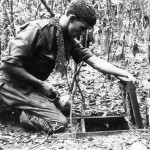
Combat troops from the United States began arriving in Vietnam in early 1965. The catalyst for this US escalation in Vietnam was Lyndon Johnson’s election victory in November 1964. With a full four year term ahead of him, Johnson now turned his full attention to Vietnam – and he was not pleased with what he saw. In South Vietnam, the Viet Cong insurgency had grown rapidly in the final months of 1964. Estimates of its numbers at this point ranged from 80,000 to 100,000. The South Vietnamese military, while expanding and improving due to American aid, was unable to respond to Viet Cong attacks. The South Vietnamese government, now led by a military junta fronted by General Nguyen Khanh, was also at risk of collapse. The junta promised a new constitution and transition to civilian government, however its members bickered over religion, political reform and their own interests. Behind the scenes, US diplomats and CIA operatives worked to hold together this ungainly mess and thwart numerous coup plots that emerged through 1964.
In Washington, Lyndon Johnson was in no mood to wait for effective government in South Vietnam. On advice from his military chiefs, the president authorised a heavy bombing campaign against North Vietnam to curtail Hanoi’s support for the Viet Cong. In January 1965, a week after his inauguration, Johnson ordered the relocation of US planes from Okinawa, Japan to Da Nang. Military planners had already drawn up a list of North Vietnamese targets: military bases, munitions dumps, fuel storage depots and critical infrastructure like roads and bridges. On February 7th 1965, the White House authorised Operation Flaming Dart, a series of targeted bombing runs against the North, purportedly in response to Viet Cong attacks. By early March this campaign had given way to Operation Rolling Thunder, a more intensive and sustained program of aerial bombardment. Rolling Thunder would continue for more than three years. It was scaled back in March 1968 and officially ended later that year. During Rolling Thunder, American aircraft flew more than 300,000 sorties over North Vietnam and Viet Cong targets, dropping 864,000 tons (more than 780 million kilograms) of bombs. Rolling Thunder is believed to have killed between 80,000 and 120,000 North Vietnamese, many of them civilians.

The first months of 1965 also saw the arrival of the first US combat troops. On March 8th some 3,500 Marines landed at ‘China Beach’, near Da Nang. These arrivals would continue regularly through 1965. American combat troops were initially tasked with defending US and South Vietnamese bases. But American military commanders in Vietnam, led by General William Westmoreland, disliked this defensive approach. In Westmoreland’s view, the best form of defence against the Viet Cong was offence. It made little sense to remain in defined areas and wait for Viet Cong ambushes when US troops could be proactively engaging with the Viet Cong, killing them or driving them out and securing the areas they currently held. The rules of engagement laid down in early 1965 were revised over time and American ground missions became more mobile, expeditious and aggressive. Marines based in Da Nang ventured further away from the city on patrols and counterinsurgency missions.

These missions required additional personnel so there were significant troop increases throughout 1965. By the end of the year, America’s initial investment of 3,500 combat troops had swelled to more than 180,000 men. This shift in tactics and deployment was seldom reflected in Johnson’s public comments on the war. The president’s usual line to the press was that US soldiers were being deployed to defend bases and support South Vietnamese forces. The reality was that American involvement was changing rapidly. By mid-1965, US combat units were joining with South Vietnamese (ARVN) troops to launch offensive operations to the north and north-west of Saigon. The first major offensive launched solely by US troops came in August 1965. During Operation Starlite, as it was known, 5,000 American soldiers decimated a 2,000-strong Viet Cong force near Chu Lai, killing or capturing more than one-quarter of them. In November American soldiers had their first major engagement against the regular North Vietnamese Army (NVA) in the Drang River valley, central Vietnam. Two US Army regiments, accompanied by air support, held off two NVA regiments in one of the Vietnam War’s few major set-piece battles. Around 1,500 NVA troops were killed while 250 American soldiers also died, most of them in one 24 hour period.
“Bomb, bomb, bomb. That’s all you know. Well, I want to know why there’s nothing else. You generals have all been educated at the expense of the taxpayer, and you’re not giving me any ideas and any solutions for this damn little piss-ant country. Now I don’t need ten generals to come in here ten times and tell me to bomb… I want some solutions. I want some answers. You get things bubbling, General.”
Lyndon Johnson, Feb. 1965
From late 1965 American battle strategies focused largely on ‘search and destroy’ missions. American troops would move into regions that were controlled by the enemy, usually by hiking or aboard helicopters. Once in these ‘hot zones’ they would locate enemy bases or tracks, laying anti-personnel mines or setting ambushes. When the enemy was located, soldiers on the ground would engage them with small arms fire, grenades and mortars. Enemy positions or concentrations could be attacked with air strikes called in by radio or, if near the coast, by naval artillery. The Vietnam War had no single frontline or theatre of war, only areas where the enemy was concentrated and active. Because of this, US commanders gauged the success of these missions by their ‘body counts’, rather than territory captured and held. These body counts were notoriously dubious: they were usually based not on actual bodies but on estimates, ground reconnaissance, radar and aerial sightings, word of mouth from observers and civilians.

American ‘search and destroy’ missions were often successful but their strategic effectiveness was limited. One of the most significant problems was the evasiveness of the Viet Cong. If attacked or outnumbered, most Viet Cong units were able to dissipate, find cover in the jungles or tunnel systems, or move out of the area altogether. American soldiers moving through these ‘hot zones’ were at risk of booby traps, such as mines and pits containing punji spikes. When American soldiers failed to locate or engage the Viet Cong in a known ‘hot zone’, there were often reprisals against civilians suspected of supporting them. Many villages had their grain stores destroyed, their wells poisoned, their livestock killed and buildings torched. American soldiers called ‘search and destroy’ operations “Zippo missions”, after a brand of cigarette lighter, because they often involved burning villages believed to be aiding the Viet Cong. There were occasional atrocities against civilians, such as the killing of 145 villagers at Thuy Bo in 1967 and the better known My Lai massacre the following year.
Once the Viet Cong was thought to have been eradicated or driven out of a particular zone, a new phase called ‘clearing and holding’ was initiated. Clearing and holding was conducted mainly by ARVN forces, supported when necessary by US personnel. It involved questioning the local population, identifying possible Viet Cong agents, locating Viet Cong supply dumps and tunnel systems, removing mines and booby traps and securing the area from further infiltration. A US Defense Department memo highlighted some of the problems in carrying out these operations:
“‘Clear and hold’ operations are… usually conducted in direct support of the Strategic Hamlet program and therefore entail the resettlement into strategic hamlets of families living in VC or uncontrolled areas… The shortcomings of [these operations] are evident. The operations seldom are successful, since the VC frequently manoeuvre to avoid the ‘sweep’ forces without a fight, only to return to the area upon the departure of the friendly forces. The confidence and support of the civilian population cannot be won by the adoption of such tactics. The people will not cooperate with friendly forces when they know that several days later, they will be abandoned to the mercy of the VC.”

The year 1966 began with Operation Crimp, a joint US-Australian mission in Binh Duong province that involved 8,000 men. Operation Crimp’s objective was to locate a significant Viet Cong headquarters, which US intelligence placed in Cu Chi, several miles north-west of Saigon. The Americans and Australians cleared the area with minimal losses, killing several dozen of the enemy and locating a complex network of Viet Cong tunnels. They failed to locate any major base, however. In February 1966, Lyndon Johnson announced that his country had around 205,000 troops in Vietnam, with more to be gradually deployed. Search and destroy operations continued through the year. One of the largest and most successful of these was Operation Attleboro (September-November 1966), which cleared a large area of South Vietnam, killing more than 2,000 Viet Cong and capturing important supply dumps. It was followed in January 1967 by Operation Cedar Falls, which aimed to drive the Viet Cong out of the ‘Iron Triangle’, a large area of South Vietnam. Cedar Falls was largely successful but it caused significant disruption and property damage, so alienated thousands of South Vietnamese civilians. Late 1966 and 1967 also saw US forces participate in more conventional engagements with NVA units.
With the escalation in US combat activity in 1965-67 came a sharp rise in the number of American deaths. Between 1956 and 1964, only 401 US personnel had died in Vietnam. This rose sharply in late 1965, both from casualties during search and destroy missions as well as Viet Cong raids, ambushes and bombings:
| US military deaths in Vietnam | |
| 1956-60 | 9 |
| 1961 | 16 |
| 1962 | 52 |
| 1963 | 118 |
| 1964 | 206 |
| 1965 | 1,863 |
| 1966 | 6,143 |
| 1967 | 11,153 |
Many historians consider this spike in US deaths in 1967 to be a turning point in public support for Vietnam. A series of Gallup polls asked Americans whether they believed direct involvement in the Vietnam War had been a mistake. In August 1965 some 61 per cent of respondents answered “no” – however, this approval steadily decreased over time, falling to 49 per cent (May 1966) and then 44 per cent (October 1967). American civilians were more scathing of the Johnson administration’s management of the war. By the end of 1967, only 39 per cent of respondents approved of the president’s handling of the situation in Vietnam. This figure would slump even further – to 26 per cent – after the Tet Offensive in early 1968.

1. In early 1965, shortly after his inauguration, US president Lyndon Johnson ordered massive bombing runs over North Vietnam, a move intended to curtail Hanoi’s support for the Viet Cong.
2. US combat troops began to arrive in Vietnam in March 1965. Their rules of engagement were initially defensive but were soon revised to allow offensive missions against the Viet Cong.
3. Most US operations in Vietnam in the mid to late 1960s were ‘search and destroy’ missions. American troops were sent into ‘hot zones’ to eradicate or drive the Viet Cong out of their strongholds.
4. The success of these operations was gauged not by territory secured but by ‘body counts’. Because it was often difficult to locate the Viet Cong, reprisals against civilians were not uncommon.
5. The escalation in US combat operations between late 1965 and 1967 also produced a rapid rise in casualties. In America, public support for the war in Vietnam, though initially strong, began to fall.
© Alpha History 2018. Content on this page may not be republished or distributed without permission. For more information please refer to our Terms of Use.
This page was written by Jennifer Llewellyn, Jim Southey and Steve Thompson. To reference this page, use the following citation:
J. Llewellyn et al, “US escalation in Vietnam”, Alpha History, accessed [today’s date], https://alphahistory.com/vietnamwar/us-escalation-in-vietnam/.
